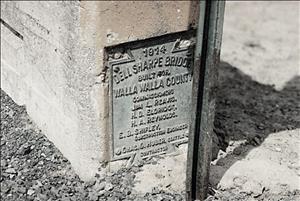In August 1914, construction begins on the Dell Sharp Bridge in Walla Walla County, five miles west of Prescott. A narrow span over the Touchet River, the bridge is one of many concrete reenforced arch-style bridges built in Eastern Washington in the period from 1908, when the Washington Street Bridge in Spokane was completed, until the mid-1930s. The Dell Sharp Bridge, with its graceful arches, will serve travelers in Walla Walla County for the next 109 years, until a replacement span is built nearby.
Concrete or Steel?
During the first two decades of the twentieth century, calls for concrete bridge construction, as opposed to steel spans, reached a fever pitch. By 1936, 31 bridges would be constructed in and around Spokane, 20 of which were built with concrete, at a cost of $2,138,548. The city's Washington Street Bridge was the first concrete arch bridge to be constructed in Eastern Washington, and quite possibly, the first in the state. Nearly half of those arch bridges were erected within the city's core between 1907 and 1917. Most of the multi-span concrete arch bridges were massive in size, some well adorned, others utilitarian in style.
In Walla Walla County, approximately 17 concrete reenforced arch bridges were constructed between 1914 and 1935, with the Dell Sharp Bridge and the Flather’s Bridge being the oldest, both built in 1914.
When Walla Walla County Commissioners and the Public Works Department debated construction methods for a bridge spanning the Touchet River along a rural highway in northern Walla Walla County, arguments centered on whether the bridge should be built of steel or concrete. County engineer Lew Loeher argued that a concrete bridge was inappropriate, mainly due to cost. But by August 7, 1914, a bid to build a concrete bridge was awarded to engineer and designer Charles G. Huber of Seattle. Still, Loeher persisted in opposition to the concrete arch bridge. As the Spokesman-Review described it:
"When the old bridge was condemned [Pettyjohn Bridge, wood truss] the commissioners ordered County Engineer Loeher to inspect the bridge and make a report. At the end of the month the board asked him for the report and he told them he had not inspected the bridge, as he had no written instructions from the board. Construction Engineer E. B. Shifley was then sent and he made a report and prepared plans and specifications for the new structure. Loeher refused to okay Shifley's plans, and the board has put the matter up to Prosecuting Attorney Stafford for an opinion" ("In Tangle ...").
By August 25, 1914, Loeher, still unrelenting, apparently presented his own inspection report to the commissioners claiming that upon inspection, the condemned wooden bridge could have been repaired for $250. Why Loeher threw a wrench into the works is unknown, other than he felt that a steel bridge would be less costly than concrete. As it turned out, Huber, the lowest bidder, presented estimates for both concrete and steel alternatives, of which the concrete was less expensive after all. Hindsight has shown that a proposed steel bridge over the Touchet River would not have lasted 108 years; the concrete structure was still operable in 2022 after 108 years, open to traffic, farm machinery, and pedestrians.
The design of the Dell Sharp Bridge has sparked on-and-off-again debate. Many current engineers have pondered whether or not Dell Sharp is in fact a Daniel B. Luten-designed concrete-rib arch bridge. Luten (1869-1946) was prolific from 1910 to the early 1930s, designing and constructing up to 20,000 bridges in 47 states. He was notorious for filing lawsuits, claiming other bridge builders had violated his patents; his fee was a 10 percent royalty. Luten's propensity to sue came to an end in 1918 when a Nebraska court deemed his claims ludicrous, as trying to construct a bridge such as the concrete arch without unknowingly violating a patent would be virtually impossible. The state of Kansas came to the same conclusion in 1919.
In 2020, the Walla Walla Public Works Department decided it was time to replace the 106-year-old span due to scouring and normal wear. In 2021, the Washington Department of Archaeology and Historic Preservation (DAHP) deemed Dell Sharp eligible under criteria C of the National Register of Historic Places (NRHP). With replacement a foregone conclusion, a Level II Mitigation was ordered to record a full history of the bridge for posterity. Many in the farm community wanted the bridge to remain in place as a pedestrian structure. Some longtime residents lobbied for the county to vacate the structure, transferring ownership to the Pettyjohn family, though the idea was just that, an idea. As of June 2022, the Dell Sharp Bridge still spanned the Touchet River, its demise to come in the near future.

